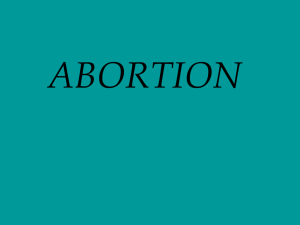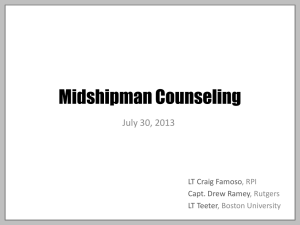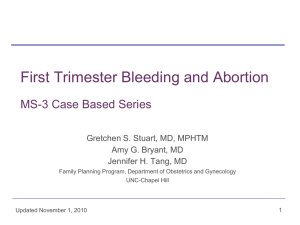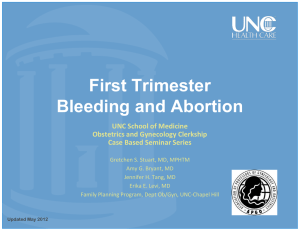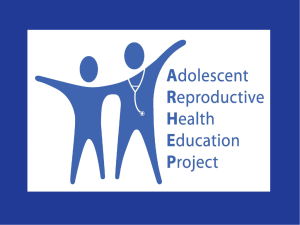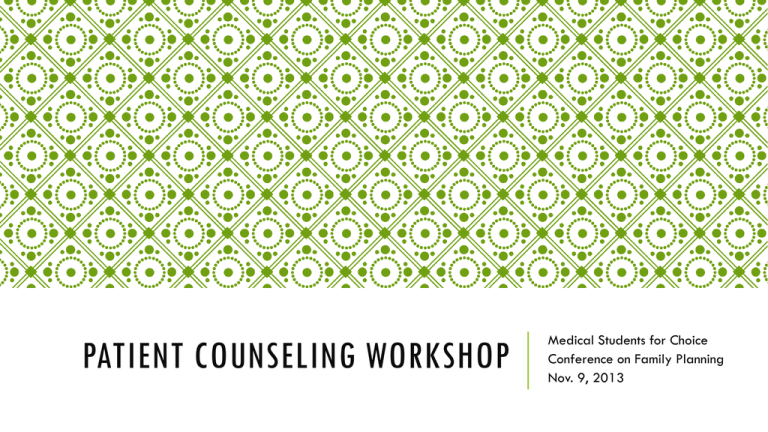
PATIENT COUNSELING WORKSHOP
Medical Students for Choice
Conference on Family Planning
Nov. 9, 2013
WHY OFFER
SHORT-TERM RELATIONSHIP COUNSELING
Purpose: patient education, informed consent, emotional care, patient screening, affirmation of
patient decision-making
Form: non-directive pregnancy options counseling, abortion counseling, post-abortion
counseling, and contraceptive counseling
Reason for offering:
Non-judgmental information-sharing is an important part of doctoring.
A rich notion of informed consent involves making space for patients to develop an
understanding of their own emotional and physical responses to an intervention and of the
experience of the procedure and risks and side effects associated with the procedure.
Counseling that affirms patients’ self-efficacy and encourages their plans to seek future
support is likely to increase overall patient satisfaction.*
*Mueller P, Major B. Self-blame, self-efficacy, and adjustment to abortion. J Personal Soc Psychol 1989; 57: 1059-68 (This is less important, however, than wait time in determining patient satisfaction after an
abortion procedure.)
COUNSELING IN THE CONTEXT OF REPRODUCTIVE
HEALTH SERVICES
Counseling includes non-verbal and verbal communication.
The work of supporting patients in the process of making decisions regarding their
pregnancies, reproductive health, sexual behavior, and contraceptive use when their
willingness to act is affected by their emotions.
Counseling can help a patient to explore, express, understand, and accept feelings so that she
can make decisions. It is also the work of supporting a patient in managing her physical and
emotional response to the experience of service provision such as a medical or surgical
abortion.
Counseling is not solving the patient’s problem for her or giving advice.
Counseling differs from ongoing therapy because it focuses on an immediate intervention
related to the services delivered by the agency for which the health care provider works.
Referrals should be made for problems outside the scope of the clinic service or the health
care providers expertise.
COUNSELING…
Is NOT about giving advice
Is NOT about knowing what the patient
“must” do
Is NOT about solving a problem
Is NOT about expunging our emotional
responses to patients or to the subjects
about which we counsel
IS about being with a patient at an important
moment in her life; using counseling skills to create
enough trust and safety for the patient to be able
to use our information in a way that supports her
and her decision.
IS about being aware of our feelings so that we
can monitor their impact on our work
IS about helping patients decide for themselves,
according to their values and the amount of
conflict the patient can tolerate
WOMEN ARE RESILIENT
Avoid the myth of post-abortion syndrome.
The APA Task Force on Mental Health and Abortion concluded that
“among adult women who have an unplanned pregnancy the relative
risk of mental health problems is no greater if they have a single
elective first-trimester abortion than if they deliver that pregnancy.”*
We should not assume that abortion is traumatic for every patient or
that abortion care causes long-term psychological damage. The
suggestion that abortion causes long-term psychological damage has
been discredited by medical and psychological research.
* American Psychological Association. Report of the APA task force on mental health and abortion. Washington, DC: American Psychological Association: 2008.
http://www.apa.org/pi/women/programs/abortion/mental-health.pdf
• “Working with ambivalence is working within the heart of
the problem.” (Miller and Rollnick)
• Some patients are able to recognize their ambivalence,
struggling with options in a thoughtful manner, even
involving others in the decision-making process. For others
the conflicts and challenges are so emotionally difficult to
Ambivalence
manage that it feels unsafe to acknowledge that the
ambivalence exists. This is often the source of denial.
• Denial works as a
• Psychic balm that soothes the pain of knowing
Denial
• Barrier protecting from painful insights others may
Fear
share
• Denial emerges as a response to the fear that one cannot
do what it would take to avoid negative consequences in a
situation.
Anger
• That fear can also manifest itself as anger.
• Anger is a way of externalizing emotion, often fear,
(unconsciously) by directing one’s feelings at a target other
than oneself.
DECISIONS
Sadness
Relief &
Regret
WAYS WE CAN MISINTERPRET EMOTIONS
Denial
Interpret as ignorance– we think someone doesn’t know the negative consequences that could
result from a behavior
Interpret as inaction– we think that someone “in denial” is not working on changing a
behavior
Resistance– we think someone’s denial has something to do with us
Anger
Resistance– we think someone’s anger is caused by us
Interpret as entitlement– we think people act angry because they think they deserve better
Remember…you are NOT the target! Understanding this does not mean you should accept
abuse from patients.
RESPONDING TO PATIENTS’ REACTIONS
Pay attention to expressed feelings of fear and sadness.
Offer referral for depression
Reframe our understanding of anger and denial
Patients are not giving you a hard time; they’re having a hard time!
3 GOALS OF COUNSELING
1. To ensure that the patient feels powerful enough in relationship with you
that he/she is willing to trust you with the truth about his/her risky behavior
and to use you as a support in the process of changing that behavior
2. To have the courage to be present to the reality of the patient’s feelings
3. To create rapport between the patient and you so that the patient can use
you in your medical caregiving role
THE 3 C’S A MODEL FOR BEGINNING INTERACTION
You are speaking with Jen, a 42 year old woman G1P1. Before running the
pregnancy test, Jen has spoken to you about her partner’s strong religious
faith and anti-choice belief. When you give her the news that the test shows
that she is pregnant, she says, with tears in her eyes:
“I know I need to make a decision, but I’m just not sure what to do.”
What do you imagine you would say to her in response?
It’s possible that you responded in one of several ways:
You asked a question to find out why she’s reacting this way
You encouraged her not to feel that way
You empathized with her feelings
Now consider what might be underlying her statement. What are some possibilities?
You can probably imagine many possibilities, but they risk being based on faulty
assumptions unless we gather better information.
THE 3 C’S
1. Confirm- This could be a statement of normalization– “This is a difficult decision” or “A lot of
women feel uncertain about how to make this decision.” A paraphrase can also be used as
confirmation : “You know you have to make a choice, but it’s not an easy one to make.” Or, if a patient
appeared upset when making the statement– as Jen’s tears suggest– you might reflect her feelings:
“Seems you’re really torn about this decision, and that’s a painful place to be.”
2. Clarify- The simplest clarification is to say, “Tell me more…” You might also ask, “What would be
good about continuing the pregnancy?” or What is the hardest thing about this decision?” The more
general and open-ended the clarification statement is, the more useful it will be in finding out what’s
really going on for the patient.
3. Counsel (or offer Content or Contract for further service)- The substance of this step is dependent
on what has emerged from the clarification. If the response reflects an expected degree of concern
and anxiety, a counseling interaction focused on eliciting and normalizing expression and experience
of the difficult feelings would be appropriate. If the patient has questions about the safety or types
of procedure available, or the effect on future fertility, you would respond with information. If the
patient shows significant emotional distress, you might contract for another visit or make a referral.
USING THE 3 C’S MODEL
The 3Cs model is a great way to begin communication with a client and works
effectively to create rapport. It is also a simple guide for responding to difficult
questions and statements- the kinds of statements we often think of as showing
“resistance.” The model begins with a respectful, empathetic, and very brief
acknowledgement of what the client has said. This is followed by a request for more
information. These steps give the provider a chance to assess her/his own ability to
respond to the client, and determine how to proceed.
GROUP DISCUSSION OF CASES
CASE 1
Amy, a 19 year old college student, comes to the clinic for a pregnancy test. She has
had unprotected intercourse with a new partner; her menstrual period is two weeks
late. The pregnancy test is positive. The patient begins to cry and says that her
parents would be so disappointed– she is the first daughter in the family to go away
to college. “They are expecting so much from me. I don’t know what to do.”
A) How would you proceed with this patient?
B) How does this change if the patient wanted an abortion because the fetus is not
the sex she desires?
C) How does this change if the woman has a drug addiction?
D) How does this change if the woman is HIV positive?
CASE 2
Janine is a 16 year old G1P0. She became pregnant once earlier this year and
decided to end the pregnancy through abortion at that time. She tells you she has
been sexually active with a new partner for several months and hasn’t had her period
during that time. She started oral contraceptives after her abortion, but didn’t return
for the follow up exam, so she ran out of pills. She and her partner have been using
withdrawal to prevent pregnancy. The patient requests a pregnancy test today. She
tells you before the test “There’s no way I’m having another abortion.”
A) How would you proceed with this patient?
B) If the test result were negative, how would you counsel the patient?
C) What special considerations would you have in this case if the test were positive?
CASE 3
Deena is a 32 year old G2P2 currently living in public housing and receiving public assistance
in the form of AFDC, Medicaid, and food stamps. This year she began studying to complete
her GED, which she hopes to complete by the end of the eyar. She comes to your clinic seeking
a pregnancy test because she hasn’t had her period “in a while.” She tells you she has been
sexually active for a short time with a new partner who recently got out of jail and is looking
for work. The test result is positive. She says, “Okay…well, I guess another one won’t make
much difference.”
A) How will you proceed with counseling this patient?
B) The patient contracts to return to your clinic the next day. When she arrives, she tells you she
has definitely decided to continue the pregnancy and to keep her child. What will you your
next steps be?
C) What would you do if she told you she had decided to continue the pregnancy but place
the child for adoption?
COUNSELING APPROACHES
1. Focus on Feelings
2. Gather and Give Information Simply
“What have you heard?”
3. Avoid why questions.
4. Offer Options, Not Directives
The If, Then model
DETACHMENT
Our most important goal is to create a relationship in which our patients are willing to
risk using us as a resource in their own change and growth. People will only allow us
to know their personal needs, fears, and failures if they feel they are not being
judged and are able to trust us. Our greatest challenge, then is to be willing to
change our own behaviors and expectations about the success of our work, and
reframe our definition of success.
We need to be able to relate to our patients with healthy detachment from ourselves–
not detachment from our patients. Let go of a model of success that means solving a
problem; that assumption leads us into anger, resentment, and frustration because we
start to see patients of the embodiment of our own inadequacies. When we can
separate ourselves from our patients’ behaviors, we can recognize the responsibility
they hold for their own decisions. We do not change our patient’s behavior; the patient
does.






